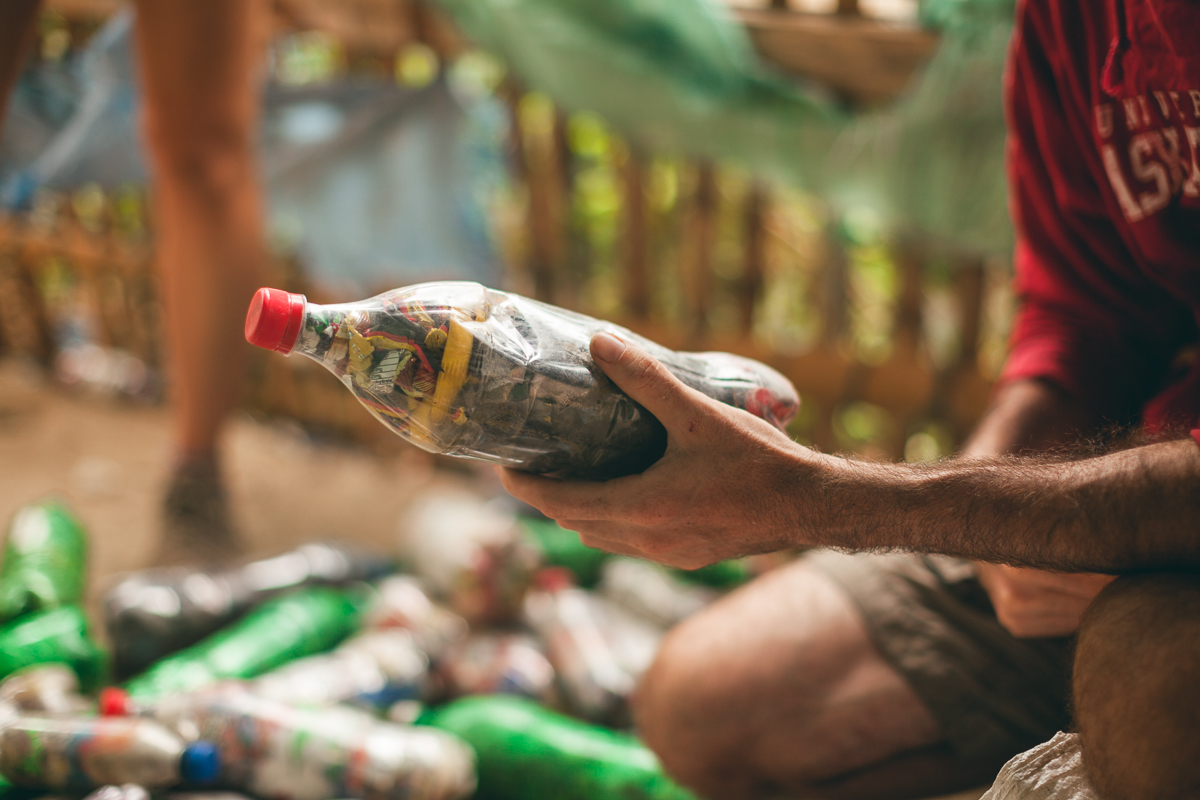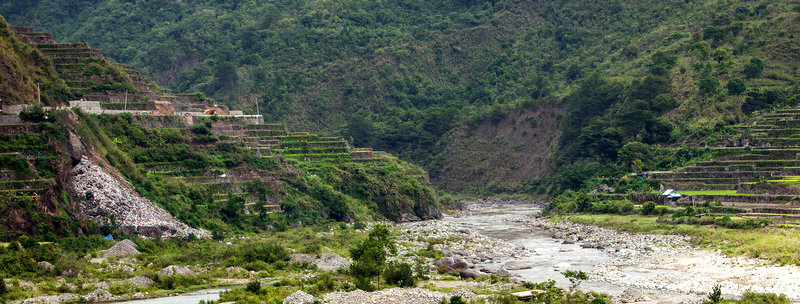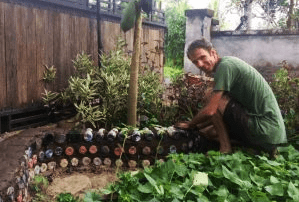We’re refining the Ecobrick methodology here in the northern Philippines. An essential part of the process is philosophical. It is essential to consider the longterm ethics of stashing plastics and potential toxics for the next 500 years into a building block. Short term the benefits are clear: encouraging segregation, avoiding short-term contaminations, enabling personal waste responsibility, and empowering individuals, schools and communities with a low cost construction alternative.
Yet, what about the longterm? Afterall, not thinking about the destination of our design is what has got us in this mess. Of course, even when the plastics are put in the bottles, they don’t go away– is the problem not being passed to future generations?
We can pose the question using the framework of William McDonough, the design theorist behind cradle-to-cradle ethics:
”How do we love all of the children of all species for all time [with our designs]? You notice that this is not how do we love our children. This is all of the children of all of the species for all time.” — William McDonough
Thus: Is Ecobricking good for all the children of all the species for the rest of time here on Earth?
I have been carefully observing the unfolding of Ecobricks in my community for two years. After much reflection, I argue in the article below that Ecobricks are a indeed a viable solution to be pursued immediately. Ecobricking allow the long term retention of control of materials that would otherwise become toxic in the short term and the long term. Because Ecobricks allow anyone to take action immediately (without the need of special equipement or politicians or facilities) vast amounts of wastes that would otherwise become toxically and inextricably intertwined with local ecosystems are instead handed down to future generations under segregated control. Finally, and most valuable of all, the process of Ecobricking encourages reflection on one’s personal responsibility for one’s wastes. This consciousness raising process is an essential step in humanity’s transition towards cycles of consumption that are in harmony with the cycles of life.
First, let us review the context of Ecobricks. The reason I began exploring packing plastics in my home in Mt. Province, in the Northern Philippines is that there was simply no reasonable place to put non-biodegradeables in my village.
For example, I love coffee. There is great locally grown coffe here and it is packaged in a brown silver lined plastic bag to preserve its freshness. The bag is made from linear low-density polyethylene which does not fit into the natural ecologies here– when burned it creates toxic dioxins and when dumped coagulates poisonous PCBs.
Once I am done with my coffee beans, the plastic’s use is over– it has become what we commonly call trash, or here basura. The plastic bag would then go into a bin. The contents of that bin then go to a bigger bin or a pile. From here, it is only a matter of weeks, months or years and it will be dumped, burned or buried leaching into the river, soil and air. Control of the item is quickly lost. Through fumes, photo-degradation and seepage the coffee bag and its component chemicals ends up into the ecosystem. There the dioxins and coagulated PCBs begin their poisonous journey in the food chain.
The predicament of my coffee bag is of course that of all the pieces of plastic in my bin, of the bin of everyone in my town, of the towns of all the province, of all the provinces in the Philippines, and of one developing country of many in exactly this contaminating dynamic. Alas the flow of plastics into uncontrolled ecological contamination is in full inexorable flow as I type and you read.
The key element in the transition of product to pollution is control. When we still have control of the coffee wrapper within our human systems of consumption there is no overt toxicity. Recycling or upcycling is rentention of control. Putting bottles and sachets to re-use retains our control of these inorganic materials. Alas in many places that are no systems, incentives or technical solutions for recycling countless types of non-biodegradeable wastes (like my plastic coffee bag). This is true even in developed countries that claim to have recycling systems. In many cases, the final attempt at retaining control becomes an ‘engineered sanitary land-fill’. However, when we begin to extend the time frame from 20 years to 100 years, even a dedicated dump site is not a solution. Examples of water table contamination in Canada, Germany and Swiztzerland testify to this*. Control literally seeps away.
Enter Ecobricks.
Making an Ecobrick makes use of the very problem (the longevity of the plastic) to seal the potential toxics away. By providing a way for anyone living in a region where there is inadequate recycling systems to segregate their non-biodegreable wastes into a composted unit (a brick) both the shorterm and longterm effects of dumping and of a dumpsite are avoided. Future generations are handed pellets of segregation rather ecosystems that are cocktails of contamination. It is indeed possible that these compacted units of plastics will be of value that we cannot yet imagine to a future humanity. Even in rare worst case scenarios where dramatic events rupture or burn or destroy Ecobrick bottles, the non-biodegradeables remain in relatively one place in comparison to their alternate unpacked destinies of flowing into rivers and oceans.
Secondly, Ecobricks are effective. For communities and regions that cannot afford costly incerators, grinders, meltors and other recycling facilities or equipement, Ecobricking lets the populace wrest control of their communityøs solid waste predicament. Through widespread collaboration plastics are put to use for communities by the communities. For communities where there are such facilities in place, Ecobricks may provide an even deeper solution. When implemented properly, ecobricking can become an accepted, everyday, long term habit for citizens. Through coordination and incentives by municipal governments it becomes even more effective at reducing a communities wastefulness.
Finally, though ecobricking has been observed to make littered plastics disappear in communities, far more significantly, Ecobricks have made the concepts of ‘trash’ and ‘basura’ disappear. In truth it is these problematic linear concepts that are the root of our pollution. Now, plastics and non-biogreadables that once had no further use or value (i.e. trash) now become use-full. They now serve a purpose and it becomes ‘wasteful’ to callously discard them. This transition from worthless to use-full is integral. It is a transition from the endemic linear thinking of the human world, to that of the cycles and circles that characterize nature– or shall we say, the real world.
The time consuming, monotonous and labourous process of packing an Ecobrick has been described by many as therapeutic and meditative. For most, it becomes an opportunity to reflect on one’s waste and its linear route. Where did it come from? Where is it going? Why is it here?
Is there a better way?
Let us be clear. Ecobricks do hand future generations a cleaner environment, but they are not a forever solution to pollution. Instead, they are an essential stepping stone in our transition to a more resonant harmony with the circles of life. And the sooner we start packing, the better for all the children of all species for all time.
—————————–
Let us consider that there are three general states Earth and Humanity could find itself in 500 years. One, a much more technologically advanced human society. Two, about the same as now. Three, we are gone or civilization has declined– for whatever reason.
First, assuming a much more advanced civilization, we can already we can see glimmers of how more advanced technology could deal with our waste problems: GMO micro-organisms that thrive on plastic, incineration, and even propelling toxic waste to the sun once we have made earth-to-orbit systems run of the mill. At this point, having placed all of our trash into one concentrated and simple container (i.e brick) could be a useful thing. Certainly better than it ending up in tiny pieces in the ocean.
In the second case, if civilization stays about the same, then the waste can stay as a brick. I have the feeling that a plastic brick encased in cement or earth with no sun-contact will actually last a lot longer than the 500 year estimate for PET bottles. In this cas we still have control over it and it hasn’t been released “wild” into the ecosystem. Also at this point, uses or value to this waste that we can’t imagine may present themselves and we would have done our progeny a favor by concentrating it so.
In the third case, where humans have gone backwards, or a specific fire or earthquake, or a major war, or natural disaster (or just sheer time) have brought about both the decline of humanity and of the plastic bottle, well, then the bricks will photo-degrade and the trash will reveal itself and slowly be subsumed into the environment. Just as it would have been tomorrow if we hadn’t made the brick in first place.
As things are going, a massive percentage of our waste is taking this course at this present moment. Just this week a big rainstorm washed all our villages trash out into the river. And, this will continue, especially in other poor countries where there is no recycling infrastructure. And once this trash has been released uncontrolled into the environment there is no easy way to take it out again.
Putting the trash into the bricks is not a perfect solution. The solution is really not having trash at all. But, for the moment, it seems the best thing we can do for the environment, and for people. And here is one final, yet I feel very important argument: e All around the world it is in the poor and powerless places that trash ends up. The consequences of the lifestyles of rich countires, of irresponsible coorporate products, and lazy goverments is like a giant tax that the poor and the environment have to pay. By taking Coke bottles, and turning them and the trash into a fundamentally useful building unit, the masses who are already struggling for decent places to live, are empowered and sheltered.
——————-
Let’s consider the worst type of waste.
Here in the villages, household batteries and electronics are a great example of bad stuff with no where to go. Alkaline disposable batteries contain small amounts of mercury! Others zinc, lead, nickel, alkalines, manganese, cadmium, and silver. Mercury, even in incredibly small doses can contaminate large areas. For single use batteries, recycling is virtually impossible (this is so even in developed countries, they aren’t recycling but put in hazardous waste dumps). Electronics are also sent to special dumps or to towns in China that disassemble by hand electronics and where the heavy metals inevitably end up contaminating the environment. This is a moral issue, even for us here in the village– exporting or burying problems doesn’t make them go away.
It is misleading however to talk about the bag “ending up in the environment”. We and it, are always in the environment. The only difference is our labeling. While in my kitchen holding coffee beans the bag was a ‘product’. When it’s use was consumed it became ‘trash’. At this point we relinquished control. At this point also, the object becomes set on its destiny as a pollutant in the water and air, then plants, animals and us.
I think we can all agree is not a good thing.
It is misleading however to talk about the bag “ending up in the environment”. We and it, are always in the environment. The only difference is our labeling. While in my kitchen holding coffee beans the bag was a ‘product’. When it’s use was consumed it became ‘trash’. At this point we relinquished control. At this point also, the object becomes set on its destiny as a pollutant in the water and air, then plants, animals and us.
I think we can all agree is not a good thing.
Remember were talking about UN-recyclable waste being stashed (waste that by definition isn’t recyclable at this moment with a very high likelihood of us losing control of). So is a bottle brick really a solution to recyclable waste?
It is misleading however to talk about the bag “ending up in the environment”. We and it, are always in the environment. The only difference is our labeling. While in my kitchen holding coffee beans the bag was a ‘product’. When it’s use was consumed it became ‘trash’. At this point we relinquished control. At this point also, the object becomes set on its destiny as a pollutant in the water and air, then plants, animals and us.
I think we can all agree is not a good thing.
Remember were talking about UN-recyclable waste being stashed (waste that by definition isn’t recyclable at this moment with a very high likelihood of us losing control of). So is a bottle brick really a solution to recyclable waste?
It is misleading however to talk about the bag “ending up in the environment”. We and it, are always in the environment. The only difference is our labeling. While in my kitchen holding coffee beans the bag was a ‘product’. When it’s use was consumed it became ‘trash’. At this point we relinquished control. At this point also, the object becomes set on its destiny as a pollutant in the water and air, then plants, animals and us.
I think we can all agree is not a good thing.
Remember were talking about UN-recyclable waste being stashed (waste that by definition isn’t recyclable at this moment with a very high likelihood of us losing control of). So is a bottle brick really a solution to recyclable waste?



